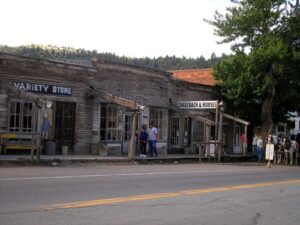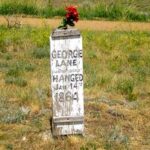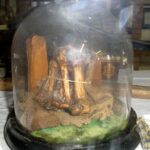
 George Lane was a shoemaker by trade, back in the mid 1800s. He also had a birth defect, that earned him the nickname he hated all his life…Clubfoot. In an event that seems rather unusual to me, Lane was accused of being a member of Henry Plummer’s gang of “Innocents” and was hanged by Montana Vigilantes in January 1864. Lane was a small man, originally from Massachusetts. He later made his way to the west during the California Gold Rush. Like many people back then, he dreamed of becoming rich, and the Goldrush seemed as likely a way as any other. Things didn’t exactly go as planned, and he ended up working first on a farm in Yuba County, before making his way to Calaveras County, where he worked as a store clerk. Not quite the glamorous outcome he had in mind.
George Lane was a shoemaker by trade, back in the mid 1800s. He also had a birth defect, that earned him the nickname he hated all his life…Clubfoot. In an event that seems rather unusual to me, Lane was accused of being a member of Henry Plummer’s gang of “Innocents” and was hanged by Montana Vigilantes in January 1864. Lane was a small man, originally from Massachusetts. He later made his way to the west during the California Gold Rush. Like many people back then, he dreamed of becoming rich, and the Goldrush seemed as likely a way as any other. Things didn’t exactly go as planned, and he ended up working first on a farm in Yuba County, before making his way to Calaveras County, where he worked as a store clerk. Not quite the glamorous outcome he had in mind.
In 1860, gold was discovered in Washington Territory, and Lane once again followed the miners, with plans to “get rich quick” forming in his head. Again, Lane ran into trouble. This time in 1862 when a Lewiston, Idaho rancher accused him and another man of “running off horses.” That “crime” didn’t really seem as serious as the rancher supposed, but then I am not a lawman. Wanting to straighten things out, Lane turned himself into the Fort Lapwai commander, who assigned them to help with building construction. The following year, he and another man were accused of a similar crime, this time, driving a stolen horse herd toward the Snake River. The alleged horse thieves escaped, and by the fall of 1863, Lane had made his way to Virginia City, Montana. His situation and the oddly recurring events, make you wonder if he was as innocent as he claimed. He did, after all, run from the law his time. He soon went to work for Dance and Stuwart’s Store, mending harnesses and making and repairing boots. It would appear that he was at least trying to lead an honest life.
Lane began earning the respect of his employers. Nevertheless, he again came under suspicion when he rode to Bannack, Montana, to inform Henry Plummer of the George Ives trial taking place in Nevada City in December 1863. Though Plummer was absent at the time, Lane told Deputies Ray and Stinson of the growing vigilance movement in Virginia City. It would seem to me that when you are suspected of being a part of a criminal gang, that should be the furthest thing from your thoughts, if you want to look innocent anyway. Because of that trip, when the Vigilance Committee met the following month, Lane’s name immediately came up as a “spy” for the outlaw gang called The Innocents.
On January 14, 1864, Lane was arrested at Dance and Stuart’s store. When he asked why he was being arrested, the men informed him, “For being a road agent, thief, and an accessory to numerous robberies and murders on the highway.” Lane responded by saying, “If you hang me, you will hang an innocent man.” While his bosses liked and respected Lane, they assumed that the vigilantes had evidence against Lane, so they did not intervene. Not everyone thought Lane was guilty, but the Committee tried him anyway and found him guilty. He was sentenced to be hanged along with Frank Parish, Boone Helm, Haze Lyons, and Jack Gallager. Lane requested a minister be brought before he was executed which was scheduled to be the first execution. Then, as he was forced to stand on a box under the noose, Lane saw a friend. He yelled out, “Goodbye, old fellow; I’m gone.” He then leaped from the box without waiting for it to be removed…going out on his own terms. He and the others hanged that day were buried in Virginia City’s Boot Hill Cemetery. As punishment, none of the graves were given markers.
Placing no markers while maybe a “fitting punishment” can later pose a problem. Weh people began to ask who 
 was in these graves, some 43 years later, it brought in question the deaths. In 1907, a former vigilante came forward, saying that he knew the order of the graves, and which one was Club Foot George’s. Their curiosity peaked now, the city soon dug up the grave that was allegedly Clubfoot George Lane’s. Everyone was surprised when he had been right. The deformed foot belonging to George Lane was indeed in the grave. The foot bones were then placed in a cabinet in the courthouse. Later, they were moved and placed on display in a glass jar at the Thompson Hickman Museum in Virginia City, Montana.
was in these graves, some 43 years later, it brought in question the deaths. In 1907, a former vigilante came forward, saying that he knew the order of the graves, and which one was Club Foot George’s. Their curiosity peaked now, the city soon dug up the grave that was allegedly Clubfoot George Lane’s. Everyone was surprised when he had been right. The deformed foot belonging to George Lane was indeed in the grave. The foot bones were then placed in a cabinet in the courthouse. Later, they were moved and placed on display in a glass jar at the Thompson Hickman Museum in Virginia City, Montana.


Leave a Reply